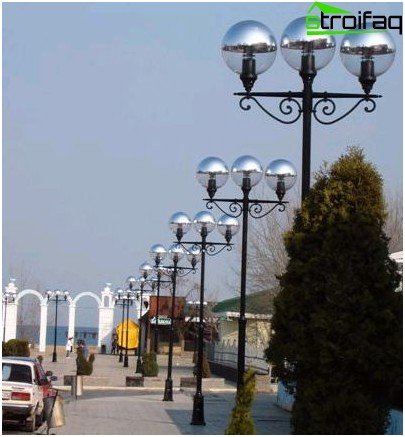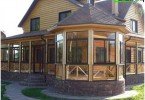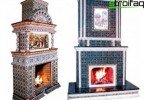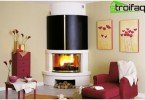Masts and lighting poles
The construction of new buildings, roads, highways and other objects does not appear without the installation of lighting devices. At the construction stage, lighting allows for round-the-clock work, which significantly reduces time costs. During subsequent operation of the facility, properly organized lighting is the key to safety and comfort. In order to achieve a high level of visibility, lighting poles are needed that are used to mount a wide variety of light sources.
Content
- Types of supports and their advantages
- Lighting Masts: Classification
- Typical installation of masts and lighting poles
Types of supports and their advantages
When buying lighting poles, many consumers are usually faced with the problem of choice. After all, each type has its own characteristics, about which not many know.
Street lighting poles can be divided into two main groups, depending on the material from which they are made.
- Lighting poles metal – the most common design. Typically, cast iron, aluminum and special steel are used for their manufacture, giving the material special properties. This type of support is highly resistant to temperature and humidity fluctuations, and also easily resists even the strongest winds. But today the most popular are aluminum lighting poles, characterized by lightness, long life and high wear resistance. I especially want to note their elasticity and flexibility, which allows to reduce the level of damage to the car in a collision with vehicles. Galvanized lighting poles are distinguished by the fact that no chips are formed on their surface, and the poles themselves are not subject to deformation..
- Reinforced concrete lighting poles are not as common as metal ones. This is due to the fact that they are influenced by most aggressive environments. To at least somehow increase reliability, manufacturers have to make them more massive, which significantly increases the weight of the structure and makes installation difficult.
Park metal lighting poles
Depending on the purpose, the outdoor lighting supports are divided into several types:
- street. They are mainly used for lighting pedestrian areas and have a universal design that allows you to fit into any landscape;
- decorative. They are distinguished by a variety of styles, original appearance and rich color scheme. Such supports can be selected for any style of terrain;
- park. Specially selected height makes them indispensable for playgrounds and recreation areas. They allow you to achieve good lighting, but do not irritate the eyes;
- trunk. Reinforced structures characterized by high strength;
- special. Designed for lighting special objects, such as stadiums.
Lighting Masts: Classification
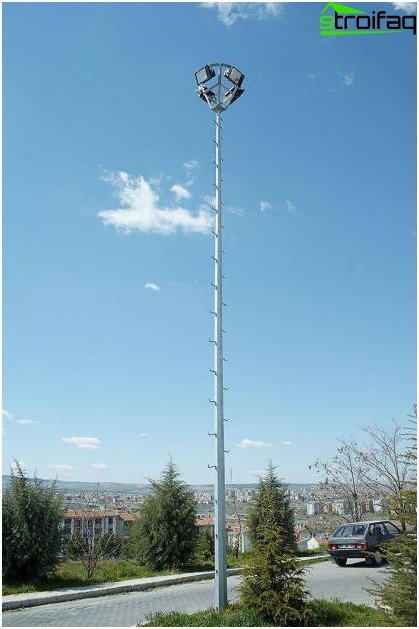
Masts of lighting with a stationary crown must be equipped with a special platform for maintenance
To illuminate a large area, it is better to use lighting masts, the height of which is selected depending on the purpose of the structure. The barrel is usually made in the form of a tubular, round or faceted conical support. In the modern market there are two types of masts:
- with a mobile crown. For such structures, a special tip is lowered with a winch, which greatly facilitates maintenance;
- with a stationary crown. Such masts are necessarily equipped with a ladder or a hydraulic lift. The main advantage of these designs is the ability to simultaneously install a large number of lighting devices.
Typical installation of masts and lighting poles
Installation of lighting poles can begin only after obtaining permission to lay electric cables, since during work there is a great danger of damage to existing utilities. To do this, it is necessary to draw up a project in which all factors will be taken into account, such as the topography, the necessary illumination, the power of the fixtures, the cross-section of the wires and the total length of the line, and submit it to the appropriate authorities.
After the approval of the project in the designated area with the help of a level, the installation sites of the masts or supports are marked. Now you can start preparing the trenches for laying the cable. If you plan to use an armored cable, the depth of the prepared trench should not be less than 800 mm from the surface of the earth. In the case of using a power cable, this value increases depending on the surrounding area to 1250 mm. A sand layer about 150 mm thick is laid in the trench and carefully spilled with water. After this, sand must be compacted to a layer of 100 mm.
Now you can start preparing the places where you plan to install outdoor lighting poles. To do this, prepare a square pit 1000×1000 mm and a depth of 1200 mm, in the center of which a hole is drilled with a depth of 1000 mm and a width equal to the diameter of the support, increased by 100 mm.
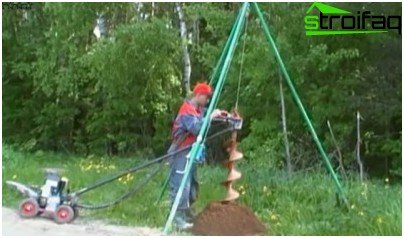
Drilling pits under lighting poles
After installation in a pit, both reinforced concrete and steel lighting poles are necessarily poured with concrete. The mortar should fill the hole and the entire pit to a height of 200 mm, forming a concrete slab holding the support. The pit can be completely filled with soil after laying the cable in the trench.
The correct operation of the masts and lighting supports depends on the correct operation of the light sources installed on them and the safety of others, so do not neglect the requirements of standards and basic standards.


